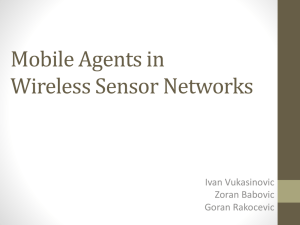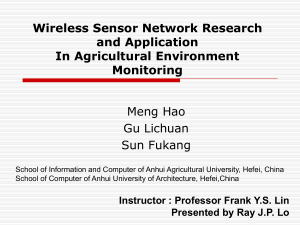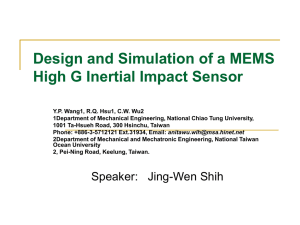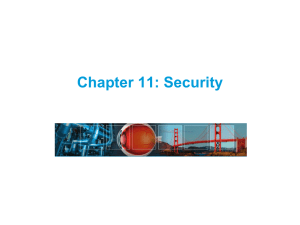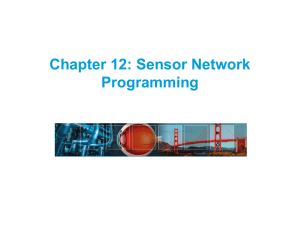Fundamentals of Wireless Sensor Networks By - Dr Ali El
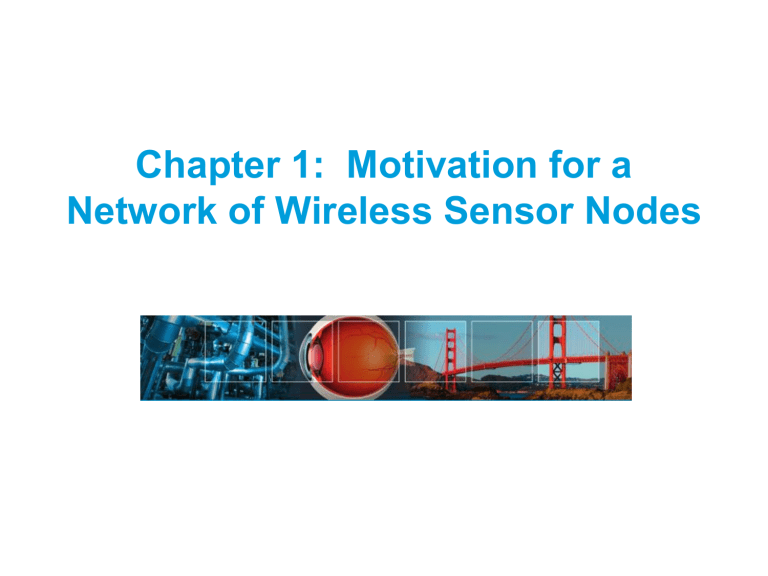
Chapter 1: Motivation for a
Network of Wireless Sensor Nodes
Who’s Who
Instructor:
Dr Ali El-Mousa elmousa@ju.edu.jo
23003
Room 415 CPE Dept
Fundamentals of Wireless Sensor Networks : Theory and Practice
Waltenegus Dargie and Christian Poellabauer © 2010
2
Web Resources
Course:
http://uojcourses.awardspace.com/Wireless%2
0Sensor%20nets/index.html
CPE Department:
http://engineering.ju.edu.jo/Departments/Home.
aspx?DeptName=Computer%20Engineering
Text book:
http://www.wiley.com//legacy/wileychi/dargie/
Fundamentals of Wireless Sensor Networks : Theory and Practice
Waltenegus Dargie and Christian Poellabauer © 2010
3
Course Description Highlights 1
Syllabus:
Motivation for a Network of Wireless Sensor Nodes
Applications
Node Architecture
Operating Systems
Medium Access Control
Network Layer Services
Network Layer
Power Management
Time Synchronization
Localization
Security
Sensor Network Programming
Text book:
Fundamentals of Wireless Sensor Networks
By: Waltenegus Dargieand, Christian Poellabauer,
Wiley, 2010 (1st Edition)
Fundamentals of Wireless Sensor Networks : Theory and Practice
Waltenegus Dargie and Christian Poellabauer © 2010
4
Course Description Highlights 2
Teaching Method:
Lectures mainly using PPT slides
Informal quizzes: Every two weeks
Grading:
Midterm exam 30%
Quizzes 20%
Final 50%
Fundamentals of Wireless Sensor Networks : Theory and Practice
Waltenegus Dargie and Christian Poellabauer © 2010
5
Answers to FAQ
Course material focuses on concepts rather than technologies.
There are no make ups for missed quizzes or exams under any circumstance. So do not be absent.
Exams will be closed notes and books and they will be time-limited.
Course material is NOT all from the text book.
Fundamentals of Wireless Sensor Networks : Theory and Practice
Waltenegus Dargie and Christian Poellabauer © 2010
6
Answers to FAQ
Focus of exam and quizzes will be on conceptual understanding, and problem-solving skill.
There will be around five quizzes.
ALL quizzes will be counted.
Every student HAS TO attend the class he/she registered in. Please DO NOT ASK for changing classes internally.
Attendance is mandatory. If you are absent for 8 classes or more then you will be banned form the final exam.
Fundamentals of Wireless Sensor Networks : Theory and Practice
Waltenegus Dargie and Christian Poellabauer © 2010
7
Chapter 1: Roadmap
Definitions and background
Challenges and constraints
Overview of topics covered
Fundamentals of Wireless Sensor Networks : Theory and Practice
Waltenegus Dargie and Christian Poellabauer © 2010
8
Sensing and Sensors
Sensing: technique to gather information about physical objects or areas
Sensor (transducer): object performing a sensing task; converting one form of energy in the physical world into electrical energy
Examples of sensors from biology: the human body
eyes: capture optical information (light)
ears: capture acoustic information (sound)
nose: captures olfactory information (smell)
skin: captures tactile information (shape, texture)
Fundamentals of Wireless Sensor Networks : Theory and Practice
Waltenegus Dargie and Christian Poellabauer © 2010
9
Sensing (Data Acquisition)
Sensors capture phenomena in the physical world (process, system, plant)
Signal conditioning prepare captured signals for further use (amplification, attenuation, filtering of unwanted frequencies, etc.)
Analog-to-digital conversion (ADC) translates analog signal into digital signal
Digital signal is processed and output is often given (via digital-analog converter and signal conditioner) to an actuator (device able to control the physical world)
Fundamentals of Wireless Sensor Networks : Theory and Practice
Waltenegus Dargie and Christian Poellabauer © 2010
10
Sensor Classifications
Physical property to be monitored determines type of required sensor
Type
Temperature
Pressure
Optical
Acoustic
Mechanical
Motion, vibration
Position
Electromagnetic
Chemical
Humidity
Radiation
Examples
Thermistors, thermocouples
Pressure gauges, barometers, ionization gauges
Photodiodes, phototransistors, infrared sensors, CCD sensors
Piezoelectric resonators, microphones
Strain gauges, tactile sensors, capacitive diaphragms, piezoresistive cells
Accelerometers, mass air flow sensors
GPS, ultrasound-based sensors, infrared-based sensors, inclinometers
Hall-effect sensors, magnetometers pH sensors, electrochemical sensors, infrared gas sensors
Capacitive and resistive sensors, hygrometers, MEMS-based humidity sensors
Ionization detectors, Geiger-Mueller counters
Fundamentals of Wireless Sensor Networks : Theory and Practice
Waltenegus Dargie and Christian Poellabauer © 2010
11
Other Classifications
Power supply:
active sensors require external power, i.e., they emit energy
(microwaves, light, sound) to trigger response or detect change in energy of transmitted signal (e.g., electromagnetic proximity sensor)
passive sensors detect energy in the environment and derive their power from this energy input (e.g., passive infrared sensor)
Electrical phenomenon:
resistive sensors use changes in electrical resistivity (ρ) based on physical properties such as temperature (resistance R = ρ*l/A)
capacitive sensors use changes in capacitor dimensions or permittivity
(ε) based on physical properties (capacitance C = ε*A/d)
inductive sensors rely on the principle of inductance (electromagnetic force is induced by fluctuating current)
piezoelectric sensors rely on materials (crystals, ceramics) that generate a displacement of charges in response to mechanical deformation
Fundamentals of Wireless Sensor Networks : Theory and Practice
Waltenegus Dargie and Christian Poellabauer © 2010
12
Example: Wheatstone Bridge Circuit
R1, R2, and R3 known (R2 adjustable)
Rx is unknown
V out
V
CC
R
3
R x
R x
R
1
R
2
R
2
Fundamentals of Wireless Sensor Networks : Theory and Practice
Waltenegus Dargie and Christian Poellabauer © 2010
13
Wireless Sensor Network (WSN)
Multiple sensors (often hundreds or thousands) form a network to cooperatively monitor large or complex physical environments
Acquired information is wirelessly communicated to a base station (BS) , which propagates the information to remote devices for storage, analysis, and processing
Fundamentals of Wireless Sensor Networks : Theory and Practice
Waltenegus Dargie and Christian Poellabauer © 2010
14
History of Wireless Sensor Networks
DARPA:
Distributed Sensor Nets Workshop (1978)
Distributed Sensor Networks (DSN) program (early 1980s)
Sensor Information Technology (SensIT) program
UCLA and Rockwell Science Center
Wireless Integrated Network Sensors (WINS)
Low Power Wireless Integrated Microsensor (LWIM) (1996)
UC-Berkeley
Smart Dust project (1999) concept of “ motes ”: extremely small sensor nodes
Berkeley Wireless Research Center (BWRC)
PicoRadio project (2000)
MIT
μAMPS (micro-Adaptive Multidomain Power-aware Sensors) (2005)
Fundamentals of Wireless Sensor Networks : Theory and Practice
Waltenegus Dargie and Christian Poellabauer © 2010
15
History of Wireless Sensor Networks
Recent commercial efforts
Crossbow ( www.xbow.com
)
Sensoria ( www.sensoria.com
)
Worldsens ( worldsens.citi.insa-lyon.fr
)
Dust Networks ( www.dustnetworks.com
)
Ember Corporation ( www.ember.com
)
Fundamentals of Wireless Sensor Networks : Theory and Practice
Waltenegus Dargie and Christian Poellabauer © 2010
16
WSN Communication
Characteristics of typical WSN:
low data rates (comparable to dial-up modems)
energy-constrained sensors
IEEE 802.11 family of standards
most widely used WLAN protocols for wireless communications in general
can be found in early sensor networks or sensors networks without stringent energy constraints
IEEE 802.15.4 is an example for a protocol that has been designed specifically for short-range communications in WSNs
low data rates
low power consumption
widely used in academic and commercial WSN solutions
Fundamentals of Wireless Sensor Networks : Theory and Practice
Waltenegus Dargie and Christian Poellabauer © 2010
17
Single-Hop versus Multi-Hop
Star topology:
every sensor communicates directly (single-hop) with the base station
may require large transmit powers and may be infeasible in large geographic areas
Mesh topology
sensors serve as relays ( forwarders ) for other sensor nodes (multi-hop)
may reduce power consumption and allows for larger coverage
introduces the problem of routing
Fundamentals of Wireless Sensor Networks : Theory and Practice
Waltenegus Dargie and Christian Poellabauer © 2010
18
Challenges in WSNs: Energy
Sensors typically powered through batteries
replace battery when depleted
recharge battery, e.g., using solar power
discard sensor node when battery depleted
For batteries that cannot be recharged, sensor node should be able to operate during its entire mission time or until battery can be replaced
Energy efficiency is affected by various aspects of sensor node/network design
Physical layer:
switching and leakage energy of CMOS-based processors
E
CPU
E switch
E leakage
C total
* V dd
2 V dd
* I leak
* t
Fundamentals of Wireless Sensor Networks : Theory and Practice
Waltenegus Dargie and Christian Poellabauer © 2010
19
Challenges in WSNs: Energy
Medium access control layer:
contention-based strategies lead to energy-costly collisions
problem of idle listening
Network layer:
responsible for finding energy-efficient routes
Operating system:
small memory footprint and efficient task switching
Security:
fast and simple algorithms for encryption, authentication, etc.
Middleware:
in-network processing of sensor data can eliminate redundant data or aggregate sensor readings
Fundamentals of Wireless Sensor Networks : Theory and Practice
Waltenegus Dargie and Christian Poellabauer © 2010
20
Challenges in WSNs: Self-Management
Ad-hoc deployment
many sensor networks are deployed “without design”
sensors dropped from airplanes (battlefield assessment)
sensors placed wherever currently needed (tracking patients in disaster zone)
moving sensors (robot teams exploring unknown terrain)
sensor node must have some or all of the following abilities
determine its location
determine identity of neighboring nodes
configure node parameters
discover route(s) to base station
initiate sensing responsibility
Fundamentals of Wireless Sensor Networks : Theory and Practice
Waltenegus Dargie and Christian Poellabauer © 2010
21
Challenges in WSNs: Self-Management
Unattended operation
once deployed, WSN must operate without human intervention
device adapts to changes in topology, density, and traffic load
device adapts in response to failures
Other terminology
self-organization is the ability to adapt configuration parameters based on system and environmental state
self-optimization is the ability to monitor and optimize the use of the limited system resources
self-protection is the ability recognize and protect from intrusions and attacks
self-healing is the ability to discover, identify, and react to network disruptions
Fundamentals of Wireless Sensor Networks : Theory and Practice
Waltenegus Dargie and Christian Poellabauer © 2010
22
Challenges in WSNs: Wireless Networks
Wireless communication faces a variety of challenges
Attenuation:
limits radio range
P r
P t d 2
Multi-hop communication:
increased failure/error probability
complicated by use of duty cycles
Fundamentals of Wireless Sensor Networks : Theory and Practice
Waltenegus Dargie and Christian Poellabauer © 2010
23
Challenges in WSNs: Decentralization
Centralized management (e.g., at the base station) of the network often not feasible to due large scale of network and energy constraints
Therefore, decentralized (or distributed ) solutions often preferred, though they may perform worse than their centralized counterparts
Example: routing
Centralized:
BS collects information from all sensor nodes
BS establishes “optimal” routes (e.g., in terms of energy)
BS informs all sensor nodes of routes
can be expensive, especially when the topology changes frequently
Decentralized:
each sensors makes routing decisions based on limited local information
routes may be nonoptimal, but route establishment/management can be much cheaper
Fundamentals of Wireless Sensor Networks : Theory and Practice
Waltenegus Dargie and Christian Poellabauer © 2010
24
Challenges in WSNs: Design Constraints
Many hardware and software limitations affect the overall system design
Examples include:
Low processing speeds (to save energy)
Low storage capacities (to allow for small form factor and to save energy)
Lack of I/O components such as GPS receivers (reduce cost, size, energy)
Lack of software features such as multi-threading (reduce software complexity)
Fundamentals of Wireless Sensor Networks : Theory and Practice
Waltenegus Dargie and Christian Poellabauer © 2010
25
Challenges in WSNs: Security
Sensor networks often monitor critical infrastructure or carry sensitive information, making them desirable targets for attacks
Attacks may be facilitated by:
remote and unattended operation
wireless communication
lack of advanced security features due to cost, form factor, or energy
Conventional security techniques often not feasible due to their computational, communication, and storage requirements
As a consequence, sensor networks require new solutions for intrusion detection, encryption, key establishment and distribution, node authentication, and secrecy
Fundamentals of Wireless Sensor Networks : Theory and Practice
Waltenegus Dargie and Christian Poellabauer © 2010
26
Comparison
Traditional Networks Wireless Sensor Networks
General-purpose design; serving many applications Single-purpose design; serving one specific application
Typical primary design concerns are network performance and latencies; energy is not a primary concern
Energy is the main constraint in the design of all node and network components
Networks are designed and engineered according to plans
Deployment, network structure, and resource use are often ad-hoc (without planning)
Devices and networks operate in controlled and mild environments
Sensor networks often operate in environments with harsh conditions
Maintenance and repair are common and networks are typically easy to access
Physical access to sensor nodes is often difficult or even impossible
Component failure is addressed through maintenance and repair
Obtaining global network knowledge is typically feasible and centralized management is possible
Component failure is expected and addressed in the design of the network
Most decisions are made localized without the support of a central manager
Fundamentals of Wireless Sensor Networks : Theory and Practice
Waltenegus Dargie and Christian Poellabauer © 2010
27



